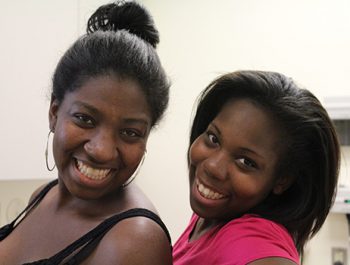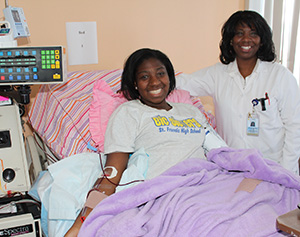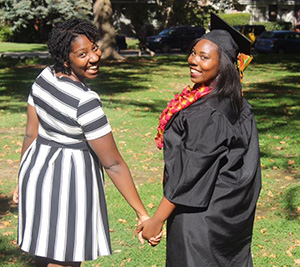
At the age of 17, Dr. Rebekah Fenton’s sister, Elisabeth Lucien, was diagnosed with Hodgkin Lymphoma. It rocked her family’s world. When Elisabeth relapsed and faced a second bone marrow transplant, Fenton, now a third-year resident at Seattle Children’s, gave her sister more than just emotional support. Below, Fenton shares her experience as a bone marrow donor.
“If you have to get cancer, this is the one to get.”
That’s what the oncologist said when he told us my sister Elisabeth had Hodgkin Lymphoma.
Stunned by the diagnosis, my parents teared up. My brother Michael and I huddled next to Elisabeth in the hospital bed and bawled. Elisabeth was stoic. She was 17.
We were told that the five-year survival rate is 90%, and we believed those odds, combined with our faith, would help Elisabeth (and us) persevere.
Fear looked like strength

What I saw externally as strength turned out to be fear and confusion for Elisabeth. Her first hospital stay was a whirlwind of chemotherapy and lab draws. When she finally went home, it was with instructions to not attend the fall semester of school because of her weakened immune system.
After rounds of chemotherapy and radiation, Elisabeth’s battle with cancer was not over. The doctors continued to monitor her for any recurrence, and unfortunately, scans showed new areas of cancer growth just weeks before her high school graduation.
Instead of preparing to go to college, Elisabeth’s post-high school summer culminated with an autologous bone marrow transplant. Doctors collected her own stem cells and stored them while they treated her with high-dose chemotherapy to wipe out her immune system and kill the cancer cells. After the therapy, doctors returned her pre-treatment stem cells via an infusion.
For Elisabeth, the months of isolation after transplant were harder than the cancer itself. She is our family’s social butterfly, and being alone triggered depression and even thoughts of suicide.
From depression to hope … then a repeat
When the doctors lifted her restrictions, Elisabeth’s positive outlook returned. She established a sense of direction and started studying social services in college. Working at adolescent group homes, she imagined a future she thought was lost.
Then, nearly three years after her original diagnosis, we learned the cancer was back … again.
But this time would be different. Elisabeth would receive a form of chemotherapy that targeted her lymphoma cells specifically. It is less toxic and had none of typical side effects of traditional chemo, like hair loss.
She also needed a second bone marrow transplant, but this time from a donor, ideally a relative. Each sibling has a one-in-four chance of being an identical match, so both my brother and I were tested.
Only about 30% of patients find a related donor match. Those who extend their search to the bone marrow registry have variable success rates dependent on race.
Thankfully, I matched perfectly! We counted our blessings.
The sister act
We both faced unique doubts leading up to the transplant. I felt the responsibility of her outcome weighing on me. Would it be my fault if the transplant didn’t cure Elisabeth?
Elisabeth struggled with the fear of death. What if it doesn’t work this time? She even stalled on her last radiation session; if she didn’t proceed, she wouldn’t have to find out.
Across the country from her, I spent the day making a video to celebrate transplant day. I remembered Elisabeth hinting at needing to repay me in some way for my sacrifice. I wanted to relieve her of any pressure; it was a gift without strings.
In the video I reassured her, “This is only the beginning. Today is the first day of the rest of your life.”
A bright future
Six years later, Elisabeth is cancer-free and no longer needs to follow up with her doctors or get repeat scans. She graduated college and is months away from obtaining a master’s degree in social work. She has a passion for adolescent empowerment with a special interest in reducing the stigma around mental health.

My sister inspires me daily in my own work with adolescents. I’m in my last year of pediatric residency training and will start specializing in adolescent medicine next year. When I see young people with chronic diseases or life-threatening illnesses like cancer, I am reminded of Elisabeth’s challenge to balance being a normal teenager with the demands of medical treatment and appointments.
Many of the teenagers I work with lack the confidence to advocate for their own interests in the way my sister did. This past year, one of my patients was diagnosed with Hodgkin Lymphoma. During our first conversation, he mentioned that he was graduating in a few weeks, but thought he probably would miss it. I encouraged him to let his doctors know he wanted to walk.
“I think they can make it work,” I said.
Weeks later, I came across a newspaper article featuring him and describing his experience with cancer. It included a picture of him crossing the stage at graduation — with his feeding tube in his nose and a stylish mullet wig. Yet another face of resilience.
If you would like to learn more about bone marrow transplants, the other diseases helped by these transplants, or if you want to sign up with the bone marrow registry, visit BeTheMatch.org.

